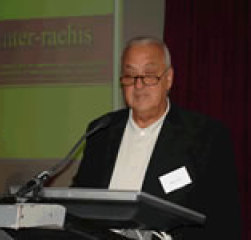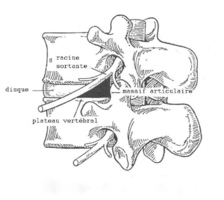
PERCUTANEOUS FORAMINOSCOPY
AND
ENDOSCOPIC DISCAL DECOMPRESSION
E.GOZLAN, B.LAVIGNOLLE, R.DUPUY, M. de SEZE, J.GUERIN, O.TROISIER,
V. LAVIGNOLLE- AURILLAC
(Zurich Janv. 2004)
STUDY DESIGN:
A prospective study concerning 114 cases with lumbar disc herniations was evaluated at 3 and 12 months post-operatively.
OBJECTIVES:
To describe the Y.E.S.S. technique (YEUNG ENDOSCOPIC SPINAL SYSTEM, WOLF) and to evaluate the efficacy of the technique, assisted with a Holmium YAG Laser (LISA), in a population suffering of a radiculopathy secondary to a lumbar disc herniation.
This study included primary, intra-canal, foraminal and extra-foraminal herniations.
It also included recurrences after conventional surgery, chymonucleolysis and percutaneous nucleotomies.
SUMMARY OF BACKGROUND DATA:
Transforaminal Endoscopic Discal Decompression is already a technique widely spread in the world.
This study takes over from our first experience of the Y.E.S.S. technique, published last year at the French G.I.E.D.A.’s congress, concerning 50 cases with lumbar disc herniations.
The statistical analysis of this prospective controlled study showed that at 3 months, the patients had significantly improved. We found that the average ofthe radicular pain was reduced by 78% on the Analogic Visual Scale (A.V.S.) and 65% for the lumbar pain. Also, the DALLAS questionnaire was reduced by 72%, and the patient rate satisfaction was 90%.
METHOD:
A prospective assessment of 114 patients was performed at 3 and 12 months after their index operation.
The outcome was graded with a A.V.S., separately for the lumbar and the radicular pain; also using the DALLAS questionnaire.
We also graded the degree of the patient’s satisfaction by recording the excellent, very good, and good results as a success, and the fair, poor and bad results as a failure.
RESULTS:
I At 3 months post-operatively we noted that:
The neurological signs had disappeared in 97% of the cases.
Also the average of:
- the lumbar pain was reduced by 66% on the A.V.S.
- the radicular pain was reduced by 83% on the A.V.S.
- the DALLAS score was reduced by 69%
- And the patient satisfaction was 89%.
II At 12 months post-operatively, the results were very nearly the same as at 3 months.
III The statistical analysis using the “Student test” was very significant(P<10-4). The patients operated with this technique had significantly improved at 3 and 12 months post-operatively, as much for their quality of life as for their lumbar and radicular pain. We didn’t note in this study any major complications. The percentage of dysesthesias was 9%, lasting less than 3 weeks.
CONCLUSIONS:
The transforaminal endoscopic approach is an interesting alternative to the traditional open transcanal discectomy. However, the major advantage of this technique is the low rate of morbidity.
Further more, this lateral approach opens the way to other techniques, such as thermomodulation, foraminoplasty, expandable intersomatic cages, neo-nucleus etc...

